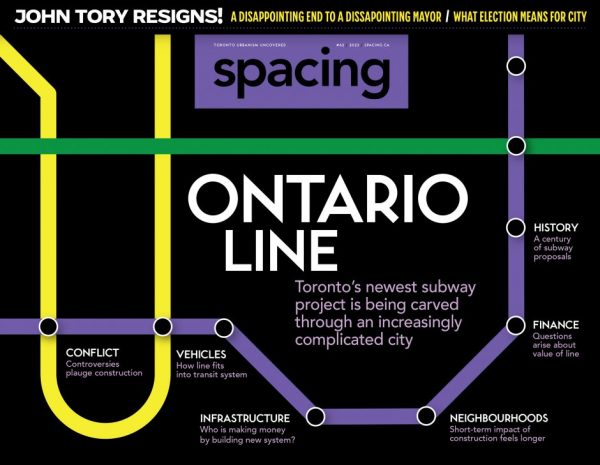Our new issue’s cover section theme echoes our previous one a little. We have gone from Ontario Place to the Ontario Line. The similar names are not entirely coincidental — the Ontario Line was named because it will start (or end, depending on your point of view) near Ontario Place and go to near the Ontario Science Centre. As well, they are both massive projects that will shape our city for generations, have been discussed for years, and have been arbitrarily redirected by Premier Doug Ford. They need to be fully discussed and understood if we care about Toronto’s future.
I live near one of the future Ontario Line stations. While my own home won’t be directly affected, the neighbourhood I’m so used to will change a great deal. First, there will be construction — creating noise, closing streets and sidewalks, eventually demolishing buildings that currently house useful stores. But that’s just the beginning — it will be accompanied and followed by intensification, completely altering the landscape I’ve been familiar with and fond of for over a decade.
The project is deeply necessary, as is the new housing that will follow. Tens of thousands of current and future Torontonians will benefit — including myself, once I have another subway route available near my home sometime in the future. But that doesn’t mean the specific choices made for the project were necessarily the best ones. Nor does it mean that the disruptions and losses I and many others will experience are any less real. The tension between the good of the many and our own individual good is one we constantly have to navigate in cities, where we are so closely packed together.
The seeds of the Ontario line were first planted over a century ago. Even once the project got some momentum in the last decade, it continued to morph endlessly. News and disputes about the project have flowed from government agencies, citizen groups, and the media in dribs and drabs — plans here, complaints there. It’s a vast project and hard to grasp in its entirety.
That’s why we’ve devoted our cover section to a comprehensive deep dive into this project. We want to give our readers the big picture. Who is doing the work? What are the changes we can expect? Where are the controversies happening? How is the line different from other TTC subways? Having all the information is the starting point for navigating the tensions that big projects bring.
Of course, navigating the tensions brought by change is nothing new in a growing city. Our front section opens with a photograph by Steven Evans that captures the cacophony of construction. Meanwhile, Sarah Hood explores how whole buildings have been moved in order to accommodate change, sometimes just by a few metres, sometimes part-way across the city. It’s a means of preserving the past while making way for the future — and sometimes it can even create a rich new context for the displaced structures.
Changes achieve their best results when there’s space for a push and pull, when different points of view can be considered and reconciled. That may not have happened enough with the Ontario Line or Ontario Place, but Ian Darragh describes how it helped improve the renovation of David A. Balfour park, as neighbours came together to press the City to reshape its plans.
But the case of Balfour Park is also a reminder that it’s never easy — that was a particularly influential and skilled group. To achieve our best future, we need to find ways to ensure all projects benefit from constructive discussion. In this vein, Aidan Brogan describes the legacy of another citizen initiative, to recognize Toronto’s Chinese presence through transliterated street signs, while Yasmin Afshar explores the need to consider our states of mind, not just our physical requirements, when we seek to create complete communities.
We were about to go to press when John Tory announced out of the blue that he would resign as mayor of Toronto. We were used to having to make sudden last-minute changes in the Rob Ford era, but Tory was supposed to be different. Yet it turns out he had secrets too – of which his underhanded minority-rule bid, only revealed post-election, might have been the most sordid, though not the most fatal. Conveniently, our theme for this issue is long-term, and the Province and Metrolinx have largely taken new rapid transit lines out of the City’s hands, for better or for worse. So we didn’t have to update mentions of Tory, but we’ve foregrounded John Lorinc’s call to take advantage of this opportunity to elect a mayor who will face up to, rather than dodge, Toronto’s accumulating challenges.
Pick up the new issue at the Spacing Store, online, or on newsstands. Subscribers will see it in their mailboxes shortly.





